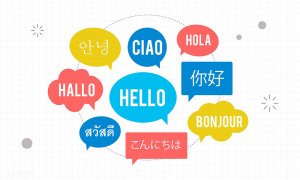For the economic sector, it is essential to get your website content accessible to all languages as quickly as possible. That content is an important part of new marketing and plays a vital role in growing your business. Today's market is global, in order to avoid limited access and business potential, website content must be promoted in the most widely used language. Through translation, your content must reach the community, cultural scene and have value to potential international customers.
In this article, we will introduce you to the concept of website localization. How can you apply technology to translate your website in the most professional way!

What Is Website Localization?
Website localization, also known as L10N, in the broader sense means translating your website into the local language. To successfully localize content for international markets, you must not only consider translating the words on the page, but also consider areas such as:
- Adjust the image to appeal to a local audience.
- Ensure website layout, support localized website language format.
- Update units of measurement, such as date and time formats.
- Include cultural norms and values from the localized area.
It is common to see websites that are originally designed for a local audience becoming more popular than their international counterparts, such as Baidu being more popular than Google in China. The primary goal of localization is to ensure that the product/service or content being offered on your website looks like it was originally created for the target market the website is localizing.
>>> See more: Full Professional Multilingual Website Translation
Why Is Website Localization Important?
One of the most compelling advantages of living in a world of relationships is that your product, service or message can reach the global market with any target audience. which. To take advantage of these international markets, your business must be able to communicate with native speakers in your native language as if the website was written for them.
Owning a multilingual website is the premise to reach the vast global market. This can change and affect your business growth, but only if you translate and localize your website content.
Popular Languages For Website Translation
Some languages are more widely spoken than others. This gives you a greater global reach for each localized language.

For example: English, Spanish and German will appeal to a large portion of the global population. While a language like Swahili has a much smaller global market reach.
When choosing a localization project scope, you need to keep costs in mind. Choosing the language with the broadest possible business appeal is the most effective decision to help you expand your message.
The languages you need to consider to reach your target audience in the most local markets are Chinese, Arabic, French, and Russian.
Top 10 Languages by Number of Speakers Worldwide in 2019
| number | Language | Speakers (millions) |
| 1 | Mandarin (language system) | 918 |
| 2 | Spanish | 460 |
| 3 | English | 379 |
| 4 | Hindi | 341 |
| 5 | Bengali | 228 |
| 6 | Portuguese | 221 |
| 7 | Russian | 154 |
| 8 | Japanese | 128 |
| 9 | West Punjabi | 92 |
| 10 | marathi | 83 |
Source: en.wikipedia.org
Basic Options For Translating A Web Page
There are several valid options for developing your multilingual website content. However, it is essential that you understand these basic options and what they can achieve in your website localization project.
1. Human Translation
One of the most important and defining characteristics of human language translation for your multilingual website is the concept of context. Context in a language is often implied rather than explicitly stated. Therefore, professional translators must understand it before starting translation work. A translator can better understand idioms, cultural norms, and most importantly, the overall purpose of the website content you want to convey and how best to translate it for your target audience. your.
If your website translations need to be as accurate and nuanced as possible, hiring a professional translator, such as can be found through the Smartcat marketplace, is highly desirable as an alternative. .
2. Machine Translation
Machine translation (MT) refers to automated software that can translate source content into the target language as part of a translation or localization effort. Even if human translation is preferred, machine translation can be a valuable tool in this process.
Machine translation is used in some important use cases, such as product descriptions that frequently change and their meanings aren't as complex as other types of content. Different MT tools may be suitable for different types of content. So you should try a few of them before choosing one.
Pro Tip: Combine any of your dozens of MT tools with Smartcat.
The main limitation of the MT is that it cannot understand and interpret the context, cultural subtleties and meanings in colloquial terms, or the changing social vocabulary of the populations of the regions. Sometimes the best option is to use post-editing, where the editor will review and change the machine-translated output to make it factually correct and grammatically coherent.
>>> See more: “Tips” for Business Website Translation Doanh
Site Localization For Popular Content Management Systems
There are two main methods of localization using translation, that is through client-side and server-side processes. Here, we'll take a look at the second option and look at the technical options for translating some of the most popular website content management systems (CMS). We'll come back to client-side localization later.
Here is a summary of the most popular CMS today
1. Translating a WordPress Website
WordPress accounts for 60% of all websites published globally, which is a huge market. There are several effective methods for translating WordPress websites and these are some of the most widely used.
WPML WordPress Plugin
The WordPress Plugin Multilingual (WPML) is a powerful extension for any WordPress website or theme to run multilingual content. The plugin allows to easily translate pages, posts, custom types, taxonomies, menus, and theme text. WPML is also a great choice for SEO on multilingual websites. However, handling the entire translation process in the WordPress admin panel can be too cumbersome and inefficient from an organizational point of view.
Smartcat Integration For WPML
Smartcat has implemented a special integration to make it easier for WPML users to localize WordPress sites. It works by linking your WordPress site to a Smartcat account and pushing the content for on-demand translation. Once the translation is done in Smartcat – by yourself, your own volunteers, or a hired vendor – the translation is automatically pulled back to WordPress for distribution.
Polylang WordPress Plugin
Another popular option for creating a multilingual WordPress site is Polylang. You write posts, pages, create categories and post tags as usual, and then define a language for each. The translation of any piece of content, whether it is in the default language or not, is optionally desired by the user. Unlike WPML, Polylang is free and open source, which is a definite advantage for many, although its user experience seems a bit more complex than that of WPML.
Polylang Smartcat . Integration
Many users prefer Polylang to WPML because the tool has the ability to use Smartcat integration to pull content from the website to the translation platform and back.
GTranslate Plugin For WordPress
The GTranslate plugin uses the Google Translate service to automatically translate WordPress sites. GTranslate works in 103 available languages making your website accessible to over 99% of internet users. Note that translation quality, factual correctness, and grammatical consistency when using a pure MT solution can become major issues as your site grows.
TranslatePress WordPress Plugin
TranslatePress gives you the ability to quickly translate entire web pages at once, including output from shortcodes, forms, and page builder. It is also compatible with WooCommerce back-ends. TranslatePress is a GPL and self-hosted translation plugin.
2. How To Translate A Joomla Website
The second most popular website CMS, Joomla, powers 6,7% of websites globally. Here are the most common options for a Joomla translation plugin.
GTranslate Joomla module
Similar to how other GTranslate modules work between popular CMS systems, GTranslate for Joomla leverages the power of Google Translate machine translation at its most basic level, with the same quality reservation we've covered performed above.
Smartcat Integration For Joomla
The extension works by linking your Joomla site to a Smartcat account and pushing content for on-demand translation. Once the translation is done in Smartcat – by yourself, volunteers or hired vendors – it is automatically pulled back to Joomla.
SEF Module Translate Joomla
This module is the free version of the Joomla Translation extension. SEF Translate can also add selected languages to the sitemap, which will improve search engine visibility and SEO ranking for other languages. You can learn more about this module here.
JV Bing Translator
This module is the first to use Microsoft's Bing Translate API. With JV Bing Translator, frontend users can translate any page of your website into any of the supported languages. Although it lacks some localization features compared to other modules, it is still a great choice for comprehensive language translation for Joomla
3. How to Translate a Drupal Website
Used by 4,7% of users worldwide, Drupal is a strong candidate to be the #2 CMS of choice for website owners. Several options when looking at the Drupal translation management tool.
Translation Management Tools For Drupal
The Translation Management Tools (TMGMT) module provides a set of tools for translating content from different sources. It basically provides connectors for various external services like Acclaro, Lionbridge or SDL. You can also use its Local Translator feature to translate your own or someone else's text. The main limitation is that in automated situations you are limited to your choice of external translation providers that have plugins specifically for Drupal, as listed on the plugin's page.
Drupal Transliteration Module
This module has not yet been ported to Drupal 8 Core. However, it does provide the ability to convert from strings directly, also known as "Romanization". While this is a “viable” option for some languages, it is not a perfect solution for full-blown localization or translation projects.
Drupal Module Localization Update
Included with Drupal 8 Core as part of the multilingual module catalog, the Drupal Localization module automatically downloads and updates your translations via updates from the localize.drupal server .org . You can learn more about recommended support modules and project information here.
Smartcat Translator Module For Drupal
The extension works by linking your Drupal site to a Smartcat account and pushing content for on-demand translation. Once the translation is done in Smartcat – by yourself, your own volunteers or hired vendors – the translation is automatically returned to Drupal.
GTranslate Module for Drupal
Just like in the case of WordPress, the GTranslate Drupal plugin uses the Google Translate automatic translation service to translate Drupal web pages.
Note: As your site grows large, translation quality can be a pressing issue that will need to be addressed.
4. How to Translate Magento Websites
Magento is an open source e-commerce platform with a 4,20% market share. There are a number of effective plugins and modules for translating websites built with Magento.
Smartcat Integration For Magento
The Smartcat extension is a great way to translate Magento archived content. The platform is user-friendly. It will connect you and your company with a range of language, translation and localization industry experts to ensure your website's content is accurate and engaging. Improving and enhancing product descriptions with the Smartcat plugin will allow you to connect more effectively with your customers and increase your sales.
AppJetty Language Translator For Magento
AppJetty leverages the Google Translate API but differentiates itself to easily manage your translations. Features like “Search & Translate” and “Bulk Translation” provide users with a powerful set of controls for seamless seamless translation. You can learn more about AppJetty here.
LingoTek | Translation Network For Magento
LingoTek is a cloud-based translation technology that uses CAT tools to facilitate language translation. This extension gives you the ability to easily translate your e-commerce site into various languages. You can learn more about LingoTek here.
Store Switcher Of Mageplaza For Magento
Store Switcher is designed to improve the customer experience no matter what country they are accessing your website from. Enabling features like currency adjustment for source country and instant viewing of product information in a visitor's native language gives shoppers a consistent experience on the site no matter where they're browsing from . You can learn more about Store Switcher here.
>>> See more: 10 Best Translation Tools For Translators
Site Localization For Popular Browsers
We have now looked at the localization options for the most popular CMSs from the client side option. In this case, you can simply use the available features of your favorite web browser. Whether it's Firefox, Chrome or Safari, you can follow simple steps to automatically translate pages as you browse.
Most popular desktop browser in 2021
1. How To Translate A Web Page In Google Chrome
By far, Google Chrome is the simplest browser to automatically translate web pages, and it's no surprise given the popularity of the Google Translate service. To enable automatic translation, you must first follow these steps:
- Click the red up arrow at the top right of your browser window.
- Navigate to the “Settings” menu item.
- Scroll down to “Languages” and click your chosen language.
- Turn on the option “Suggest to translate pages not in a language you can read”.
- You will now be prompted to automatically translate any web page that is not in your chosen language with the click of a button.
2. How To Translate A Web Page In Firefox
While Firefox doesn't have a native one-click translation option, you can add more languages to the browser through the “Language and Appearance” section of the “Settings” menu. However, there are add-ons for Firefox that will allow you to translate web pages as needed. Let's take a look at a few of them.
Google Translate Add-ons
This allows you to click on the context menu and send the selected text to Google Translate. While this is limited to basic machine translation, it is a good option for Firefox users.
Google Translator Add-on for Firefox
Google Translator for Firefox is easy to set up and allows to translate any text into any supported language with just one click, similar to how Chrome handles automatic web page translation. Options are available to translate and replace selected text or translate the entire page at once.
Google Translate Extension, ImTranslator, Dictionary, TTS
This is a newer add-on for Firefox that has some of the most powerful options for translation and localization in the Firefox browser. Features of this add-on include an inline translator, dictionary, access to Google Translate, Microsoft Translator, and quick localization options. You can learn more about this add-on here.
3. How To Translate Web Pages On Mac In Safari
Mate translate
Mate Translate is a convenient way to translate selected text when you're on the internet. Highlight text on any web page to translate it. Mate currently supports 103 different languages. You can learn more about Mate Translate here.
Polyglot
Polyglot is a simple yet effective connector that gives you the ability to translate any text into your native language using Google Translate.
TranslateMe
The TranslateMe mission gives you access to the entire web. With a simple to use click or button option, you can translate entire web pages or selected text. You can download or learn more about TranslateMe here.
Website Localization For Handsets
Today more than ever, people need to be able to use web tools and browsers efficiently on the go, no matter what country they are in or whatever language they speak. The ability to translate web pages on the go no matter what device you're using is crucial.
How to Translate Web on iPhone
iPhone users have a simple way to translate any web page they find using Microsoft's translator, a free download from Apple's app store. To use Safari on iPhone while viewing a web page, tap the “Share” button and scroll left and tap the “More” button. You should now see a “Microsoft Translator” option and select “enable”, then tap “Done”.
When you're browsing a web page in Safari on iPhone that you want to translate, tap the "share" button and then the "Microsoft Translate" button to translate the entire web page for you. While it's a bit limited, it's a great option for translating web pages on the go via mobile devices.
Web Services on Android Phones
Translating web pages on any Android device is as simple as using Google Translate in the built-in Chrome browser. Open the Chrome app, and when visiting a website in another language, select “More,” then select the target language at the bottom of the page. Chrome will offer to translate the web page once, or translate it all the time.
Conclusion
Regardless of whether you want a simple or complex and comprehensive translation for your CMS system, there are many options available for you to use. From free browser features or add-ons to fully featured localization software and professional human localization services, now you don't need to limit your browser or business. do your business with only your native language.
Are you ready to go global? Go global with Smartcat!
Sharing Translation Experience

Nguyen Trung Khang - Talented interpreter and translator, passionate about translation
Nguyen Trung Khang is a talented interpreter and translator, with many years of experience in the field of translation and linguistics. He graduated from Ho Chi Minh City University of Education, majoring in Linguistics in 2015.
After graduating, Mr. Khang participated in a professional interpretation and interpretation training course at the University of Foreign Languages - Hanoi National University. He achieved a high-level certificate in interpreting and interpreting, and was also awarded a master's degree in linguistics.

